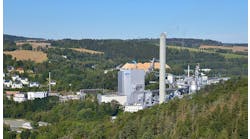When the Alcoa plant in Baie-Comeau, Quebec, needed to add a rectifier system to increase potline current and provide additional redundancy, it asked ABB to take full lump-sum, turnkey (LSTK) system responsibility for conceptual design, scope definition, costing, detailed system design, equipment engineering, project management, procurement, civil works, installation and commissioning. Alcoa provided project monitoring, technical review, subcontractor approval and compliance with internal processes.
The project was presented in the session, “Lump-sum, turnkey project partnering approach to reduce overall project cost” at ABB Customer World this week in Houston.
Alcoa Baie-Comeau’s TR49 project to add a 50 kA, 1120 VDC transformer began in April 2015 and was completed in August 2016. Equipment and ABB services were part of a LSTK project, with installation and civil work on a “cost plus” basis. Alcoa and ABB worked directly together, with ABB assuming most of the responsibilities traditionally expected of the EPC.
Along with saving money, eliminating the EPC ensured that resources stayed focused on project deliverables, not on preparing RFQs, evaluating bids or sitting in meetings.
But it was not all wine and roses.
Phase by phase
Like most projects, this one proceeded in three stages. Phase 1 was the definition stage, before funding or approval, where ABB and Alcoa openly discussed needs and what Alcoa was trying to achieve. “The big change here was that there was no EPC between Alcoa and ABB,” said Gilles Schami, Eng., operations manager, aluminum electrification, ABB.
“ABB was part of the very first stage,” said Patrice Dubé, Eng., project director, Alcoa Canada Co. “There’s a risk in not getting competitive bids, but we knew we would be getting the right technical package. We have plants around the world and we know the price of a transformer. Instead of competitive bids, we used our experience to evaluate costs.”
[sidebar id =1]
In phase 1, “All the different experts pulled together, and all the different aspects were considered,” said Schami. “At this point, we were not selecting a transformer, just defining the needs.” They looked at the engineering to tie into the existing plant, the civil engineering, mechanical engineering and electrical engineering. They evaluated the harmonics and the impact on power quality.
Phase 2 covered negotiations between Alcoa and ABB, adjustments to the solution, and final approval. “Here we saw discussion within Alcoa, and iterative processes to get agreement,” Schami said. Discussions defined the solution, scope, who would do what, and assumptions such as currency exchange rates. “We hedged on currencies, with most of the risk taken on by ABB,” he said.
The second stage also included provision of drawings, schedules and other deliverables, the same as would typically be done by an EPC. Alcoa paid ABB at this point for the deliverables, but the payment was part of the agreed-upon total cost, not a separate charge as it would typically be with an EPC.
“It was a very transparent process,” said Dubé, and Alcoa engineers were much involved. “We were buying performance, but we still reviewed all the specs and drawings, playing some of the role of the EPC. We would have had to do this even with an EPC, but we were pretty lean, with only five people on the Alcoa team, so this was a noticeable amount of work.”
Phase 3 was project execution. “All aspects were the same as any turnkey project, all the way to final acceptance,” said Schami. For civil and other contracted work, “ABB would recommend contractors, and Alcoa would make the selection,” he said. “Then we managed the contractors.”
Since the project specifications were performance-based, Alcoa didn’t have to worry as much as they otherwise would have about meeting individual specifications. “We guaranteed performance, not just the specifications,” said Schami.
The transformer was part of a larger project that had high visibility at Alcoa. ABB was responsible for the transformer, but Alcoa was responsible for the overall project. “ABB covered their scope, but we needed to get certain information from them to know we were on track,” said Dubé. At first, this led to some culture clash and friction. “We had to align and develop that,” he said.
Alcoa’s involvement during execution was mainly supervisory. It kept full control of the process, schedule and budget, with weekly progress reports from ABB. “We had access to all the field acceptance tests (FAT) as they were done, wherever they took place,” said Dubé. “We had one site manager because the work was being done on our site, and one EHS manager to satisfy regulatory requirements.”
At the end, the availability of 50 kA was measured at the bus bars, and the measured power quality met specifications.
Not for every project
A partnering approach is not for all projects: understand the factors that need to be considered before pursuing such an approach, Dubé recommended. “There is less perceived control without the EPC. You have to learn about that and accept it. You have to know your partner.”
There will be issues and when they arise, a collaborative, open-minded team environment with both sides sharing risk and working together is needed for success. “Even though it’s lump-sum and turnkey, we had to be able to see enough to manage it,” Dubé said. “Sometimes we were too close, with weekly schedule monitoring, but these projects had very high visibility within Alcoa due to the level of spending.”
Both teams focus on project delivery—on results—and level of involvement is mutually higher given the accountability of both parties. “The beauty of it is, they’re as stuck as we are for on-time delivery,” said Dubé.
The project was delivered within schedule, within the cost estimate, and within the quality standard, with no EHS incident. “Project delivery was not perfect, but we delivered because we worked jointly as a team,” said Dubé. “On a $25 million project, you could expect to save a minimum of $1 million. We estimate we saved $1-2 million.
“We’re engaged with ABB now in a second project on the site, and it’s smooth sailing.”




